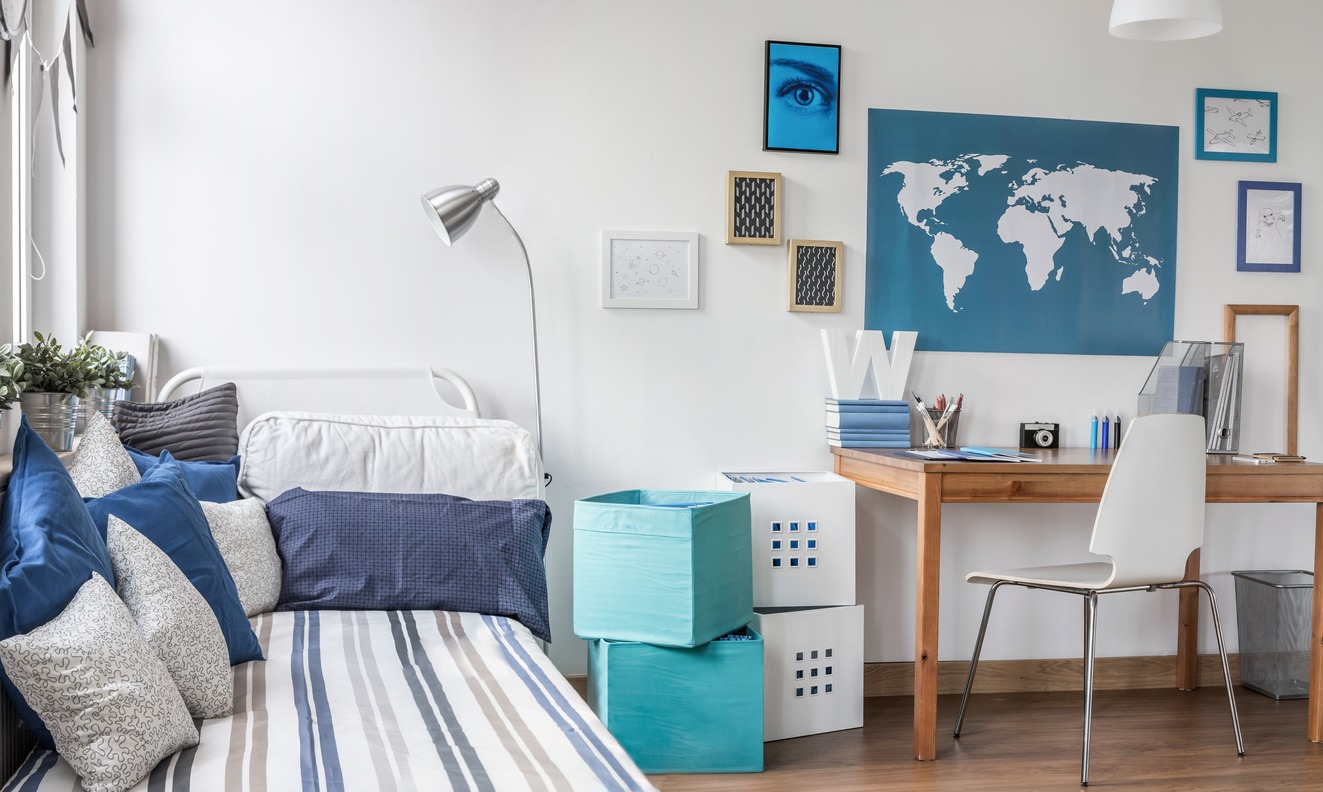As a parent, you know how challenging it is to encourage your child to study. For this reason, refurbish your kid’s room with colors conducive to active learning and studying.
The environment is crucial to a child’s ability to focus and study effectively. The colors and atmosphere of their room can significantly influence their concentration, creativity, and overall mood. Selecting the right paint colors and thoughtful design elements enables parents to create a supportive study space that fosters a positive learning environment, helping children thrive academically and emotionally.
The Psychology of Color: How Colors Affect Focus and Learning
Color psychology explores how colors influence emotions, behaviors, and mental states. Research shows that specific colors can significantly impact concentration, creativity, and overall mood:
1. Concentration and Focus:
- Blue: Often associated with calmness and stability, blue can enhance focus and productivity, making it ideal for work or study environments.
- Green: Representing nature, green promotes relaxation and balance, which can help maintain focus during extended tasks.
2. Calmness:
- Soft Neutrals: Colors like beige and light gray create a soothing atmosphere that reduces anxiety and fosters concentration.
- Lavender: This gentle hue can promote tranquility and ease stress, supporting a calm mental state.
3. Creativity:
- Yellow: Bright and cheerful, yellow stimulates optimism and energy, often sparking creativity and innovative thinking.
- Orange: This vibrant color encourages enthusiasm and warmth, fostering an inviting environment for creative collaboration.
Emotional and Psychological Responses by Color
- Red: Stimulates excitement and energy but can also increase stress if overused.
- Pink: Known for its calming effects, it can evoke feelings of peace and affection.
- Purple: Associated with luxury and creativity, it can inspire imaginative thinking.
- Brown: Earthy and stable, brown can promote a sense of comfort and reliability.
- Black: Evokes sophistication but can also feel overwhelming if used excessively.
Understanding color psychology can help create environments that enhance focus, calm the mind, and stimulate creativity, impacting learning and productivity.
Best Colors for a Study-Friendly Environment

Blue
Shades of blue are renowned for their calming and focusing effects, which can significantly help children concentrate while studying.
Lighter tones, like sky blue, are soothing and create a serene atmosphere, making them ideal for relaxation.
In contrast, deeper blues, such as navy or cobalt, can enhance mental clarity and promote a focused mindset, making them suitable for older children who need to concentrate on complex tasks.
Green
Green, often associated with nature, promotes balance, calmness, and mental refreshment. Its calming effect can reduce stress levels, allowing children to maintain focus during long study sessions.
Soft greens, like mint or sage, create a peaceful environment, while more vibrant shades can add a lively touch without overwhelming the senses, making green an excellent choice for a study space.
Yellow
Yellow stimulates creativity and energy, making it a fantastic color for fostering an uplifting atmosphere.
Soft or muted yellows can enhance positivity and encourage inspiration without being overly stimulating. This color is particularly beneficial for artistic or imaginative children who thrive in an environment that sparks creativity while still allowing them to concentrate on their work.
Neutrals (Light Grey, Off-White, Beige)
Neutral tones create a clean, distraction-free environment, allowing the mind to focus on studies without the interference of bold colors. Light grey, off-white, and beige provide a calm backdrop that promotes concentration.
These tones work well as base colors, allowing for the addition of pops of brighter colors through furniture, accessories, or wall art, creating a balanced and visually appealing study space.
Accent Walls and Color Zoning for Study Areas
Creating a designated “study zone” within a room can greatly enhance focus and productivity for children. Here are some ideas for using accent walls and color zoning:
- Accent Wall: Paint the wall behind the desk a different shade to create a visual boundary for the study area. This can help signal to the child that it’s time to focus.
- Color Blocking: Use contrasting colors or a different shade for the study area than the rest of the room. This mental separation helps children switch between relaxation and concentration modes effectively.
- Color-Coded Sections: Consider color-coding different sections of the room. For example, use calming colors like soft blues for the study area and brighter, more vibrant colors for play zones. This not only organizes the space but also enhances the overall aesthetic.
Implementing these techniques can create a functional and inviting study environment, fostering better focus and organization.
Consider the Child’s Personal Preferences
When painting a child’s room to encourage study, involving them in the color selection process is crucial. Their personal preferences can significantly impact their comfort and motivation in the space. Here are some tips to strike a balance:
- Discuss Preferences: Have an open conversation about their favorite colors. Understanding what they love can help tailor the design to their tastes.
- Choose Complementary Tones: Select hues that resonate with their favorites but are also calming or stimulating. For example, if they love bright yellow, consider a soft pastel yellow paired with neutral accents.
- Create Accent Areas: Use their favorite colors as accents—on a feature wall, furniture, or decor—while keeping the main walls in more subdued, learning-friendly tones like light blue or green.
- Test Samples: Let them choose a few paint samples and observe how they feel in the room. This can help ensure they’re happy with the final result while promoting a conducive study environment.
Paint Finishes that Support Focus and Comfort
When selecting paint finishes for a child’s room, it’s important to choose practical options that support focus and comfort. Satin or eggshell finishes are ideal because they balance durability and a soft sheen, making them easy to clean without being overly shiny or distracting.
Durable finishes contribute to a fresh, organized appearance, helping to maintain focus in the space. They resist stains and scuffs, ensuring the room remains inviting and visually calming, which is essential for a productive and comfortable environment for children.
Using Chalkboard or Whiteboard Paint for Study Spaces
Using chalkboard or whiteboard paint on one wall in a study space can transform the area into an interactive and functional environment. This writable surface is perfect for brainstorming ideas, practicing math problems, and organizing study schedules, making learning more dynamic and engaging.
Beyond study purposes, these surfaces offer versatility for creative expression. Users can sketch, doodle, or jot down inspiring quotes, allowing for personal touches and fostering creativity. Whether for studying or artistic endeavors, chalkboard and whiteboard paint add practicality and fun to any learning space.
Incorporating Visual Cues and Study Themes
To create a conducive study environment in a child’s room, consider these strategies:
- Painted Visual Cues: Designate small wall areas to feature motivational phrases or educational themes. For example, you could paint a world map, the alphabet, or geometric shapes. These visuals can inspire curiosity and encourage learning.
- Stencils and Wall Decals: Use stencils or removable wall decals to enhance the painted areas. You could add fun shapes, animals, or inspirational quotes that align with the educational themes. This approach keeps the room visually engaging without overwhelming the space, making study time more enjoyable for your child.
The Importance of Lighting in a Study Space
Lighting is crucial in creating an effective study environment for children. The color of the walls interacts with the room’s lighting to enhance focus and comfort. Lighter wall colors, such as soft pastels or neutral tones, reflect natural light, making the space more open and inviting. In contrast, darker colors can absorb light, requiring more effective artificial lighting to ensure adequate visibility.
To optimize the study space, prioritize soft, natural light whenever possible, as it promotes alertness and reduces eye strain. If natural light is limited, use warm artificial lighting that complements the wall colors, creating a cozy atmosphere conducive to concentration. Warm lights can enhance softer hues, making the room feel nurturing and encouraging productive study sessions.
Creating a Calming Environment for Breaks
Creating a calming environment in a child’s room is essential for balancing focus and relaxation, especially while refurbishing the space for learning and studying. While it’s important to have areas that promote concentration, incorporating a cozy nook or lounge area allows the child to unwind between study sessions.
In this relaxation space, opt for softer, calming colors like pastel shades or muted tones, as they foster rest and enhance mental clarity. This thoughtful design helps create a harmonious atmosphere that supports both productivity and downtime, encouraging a well-rounded approach to learning.
Conclusion
Choosing the right colors for a child’s study space is essential for supporting focus, creativity, and comfort. Calming tones can enhance concentration, while vibrant accents stimulate the imagination.
Parents should consider functional and aesthetic elements when painting a child’s room, ensuring the environment promotes learning and well-being. A balanced, thoughtfully designed space can inspire productivity and provide a comforting, motivating atmosphere for growth and development.
Let Custom Painting, Inc. help you choose the best colors for your living spaces and provide you with quality, long-lasting painting services. Call us at 925-294-8062 or message us on our contact page for a free consultation.


